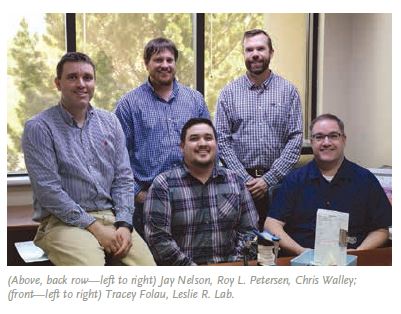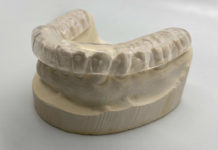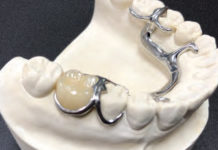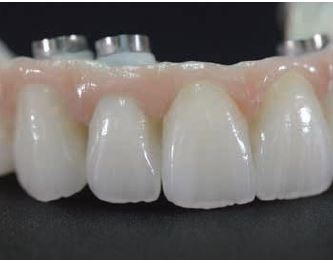
The Requirements and Benefits of Hybrid Zirconia Restorations.
Aesthetic Dentistry recently spoke with Arrowhead Dental Lab’s hybrid zirconia restoration team to learn more about this unique appliance. Members of the team include: Tracey Folau (TF)—CAD Technician, Leslie R. Lab (LL)—Implant Technical Support Specialist, Jay Nelson (JN)—CAD/CAM Department Manager, Roy L. Petersen (RP)—Ceramic Department Manager, and Chris Walley (CW)—Ceramic Training Specialist. Together, they shared their insights regarding best practices for hybrid zirconia restorations and how to ensure success for doctors and patients.
AD: What is a hybrid zirconia restoration?
LL: This restoration is an aesthetic hybrid (a full zirconia bridge on a Ti-base) with implants. There are two main variations of the hybrid zirconia restoration: a monolithic approach, where it’s made out of a block of zirconia and stained by an expert for aesthetics, and a second approach for a higher aesthetic outcome, where IPS e.max® crowns are individually created and cemented to the zirconia bar. For both restorations, the technicians at Arrowhead Dental Lab start with the implant, design the zirconia frame, stack the zirconia, and then build the pink porcelain on it. If requested, we make the entire unit screw-retained. Generally, the best way to make it is on multi-angled abutments—non-engaging fixtures that can add some tissue height or angle correction within the design of the frame.
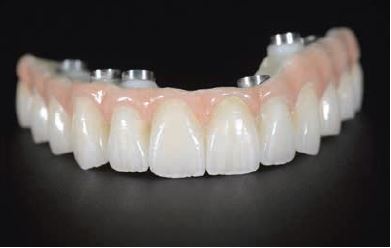
AD: Why should dentists use a hybrid zirconia restoration?
CW: It’s a more robust restoration, versus a standard denture on an abutment. Also, it’s more aesthetically pleasing. The full zirconia restoration is milled out of a zirconia puck and then sintered. It’s a solid piece of zirconia, with the exception of the pink porcelain (an aesthetic embellishment on top of the zirconia). Because it’s a monolithic restoration, it’s incredibly durable. They’re tough! However, a standard denture is still a great option for patients on a more limited budget.
AD: Which patients should consider the hybrid zirconia restoration?
LL: It’s specifically designed for an edentulous (or soon-to-be edentulous) patient whose case fits within specific parameters—primarily, he or she needs sufficient room in the vertical. In an ideal situation, we ask for at least 15 millimeters per arch (that’s also for the posterior). The doctors should work closely with their patients and the lab to determine the best direction in order to establish the vertical.
Patients who are unable to open comfortably to accommodate a zirconia hybrid restoration can still be restored with an acrylic denture hybrid instead. But for the hybrid zirconia restoration, it’s important that the patient has enough room in their arch. In some cases, a doctor or surgeon can reduce some of the bone to make enough room for the implant restoration.
AD: Why would a doctor use this restoration instead of a standard denture?
JN: It’s really for a dentist who wants to deliver high-end dentistry, and who wants the best aesthetic and functional outcome for their patients. This is a highly-customized, aesthetic product that will return the patient to as close to full function as any product on the market.
CW: Overall aesthetics are superior with this restoration. Tooth placement, zenith, arch form, Curve of Spee, and Curve of Wilson—all appear more natural with the full hybrid zirconia.
With standard dentures, there’s usually a fixed format (pre-made designs) to save costs. For certain patients, dentures are great because they still get improved function and aesthetics at a lower price point.
However, with the hybrid zirconia restoration, patients and doctors can choose a smile design, a tooth shape, tooth height, and tooth width—just about anything that the patient or doctor desires. If the patient wants flat incisal edges, we can do that. If the patient wants oval, youthful teeth—it’s all achievable. A hybrid zirconia restoration is the most aesthetic, functional, and durable option available for edentulous patients. It’s truly a customized outcome.
AD: What can patients expect in terms of maintenance with standard dentures?
LL: Standard dentures generally require more maintenance than hybrid restorations. Typically, standard dentures eventually wear down and they have to be replaced. Also, patients have to visit the dentist more often for cleanings and repairs.
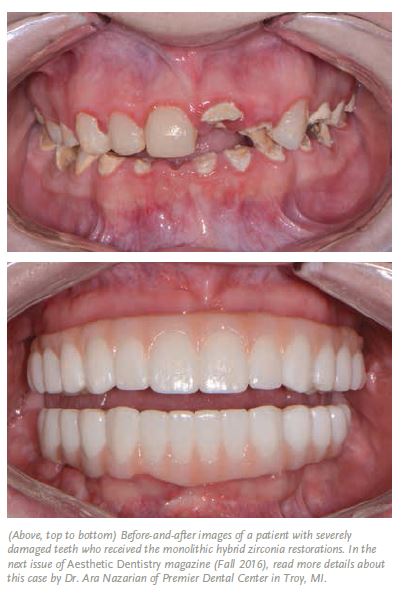
AD: Is overall maintenance decreased with a hybrid zirconia restoration?
LL: Yes. With the hybrid zirconia restoration, which can be screw-retained, the dentist has the ability to remove the prosthesis and give it a thorough cleaning. However, the patient still should be extremely conscientious and diligent with daily dental hygiene. All patients with these restorations should purchase a Waterpik® to flush underneath the appliance, in additional to having good hygiene habits. These hybrid restorations will not have a full seal, especially on the lowers, and poor hygiene can lead to buildup on the original abutment.
Periodontal problems typically cause patients to become edentulous in the first place, and the issues that caused the periodontal disease don’t magically go away with these restorations. In addition to good dental hygiene, patients should visit their dentists for regular cleanings and maintenance. When they do, the dentist will take the screws out to clean the device and then replace the screws with new ones.
Many patients experience increased function with these restorations (compared with standard dentures). If someone has a traditional denture, even if it’s held in place with paste or locators, certain food—particularly food that requires a grinding motion to break down—just cannot be consumed.
AD: Is this restoration recommended for patients who have lost their teeth due to an accident or other problems?
RP: Yes. We received a case for a young woman whose teeth were severely damaged (see before-and-after photos). Dr. Ara Nazarian of Premiere Dental Center in Troy, MI—a dentist with an emphasis on comprehensive and restorative care—removed all the young woman’s natural teeth and put in six upper and six lower implants. The hybrid zirconia restoration gave the patient the best possible outcome for the long term. It restored proper function.
AD: Can you describe the process of fabricating these restorations?
RP: For the highest aesthetic hybrid restoration, we build the crowns one-by-one and bond them to the zirconia. The advantage of doing that is if a patient breaks one tooth, we don’t have to remake the full restoration. If a patient were to chip it, a doctor could take it out of the patient’s mouth, and re-prep that one tooth or send it in to the lab for us to re-prep that tooth. Then the doctor could place that crown back onto the restoration. As mentioned earlier, we can also do a one-piece monolithic restoration (which has a different fabrication process). Each hybrid zirconia restoration case is going to be different because we can customize it for a specific patient.
TF: Once the model work is completed, the case is sent to Arrowhead’s CAD/CAM team, where the upper and lower models are scanned and correlated. A CAD technician then designs the restoration according to instructions given by the dentist in the prescription. Before the restoration is milled, an expert ceramist checks the design and may suggest any improvements. When the ceramist is satisfied with the design, it is milled out of a zirconia puck. The milled restoration is then given to a ceramist who refines embrasures and surface textures as needed.
Next, a staining specialist gives it a natural shade and translucency. The restoration is then seated to the model and pink porcelain is applied. Any needed adjustments are made to the occlusion or intaglio surface before the restoration goes through the final stain and glaze process. Afterwards, a final quality check is completed and the restoration is shipped to the doctor.
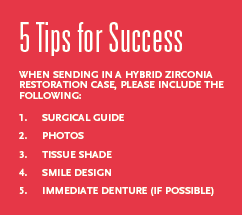
AD: What can patients expect immediately after treatment for a hybrid restoration?
LL: After the initial surgery, patients should eat a soft or liquid diet for the first two weeks. That’s generally how long it takes for the implants to assimilate. After that, patients should continue on a soft diet while slowly introducing harder foods (when the patient is wearing temporaries or immediate dentures). By the time the patient gets the full zirconia restoration, he or she should be able to eat foods that might be difficult or impossible to consume with a standard denture.
AD: How should a dentist case-plan for this restoration?
CW: The dentist should closely collaborate with the lab. Every restoration is so customized, if we only get an impression (which we see a lot) without additional details, we frequently have to go back-and-forth with the office.
LL: Yes, as with all restorations, the better the planning, the better the outcome. To emphasize again, it’s critical to have the vertical dimension dialed in. The patient has to be comfortable with the vertical. If the dentist opens it up too wide, it can be problematic for the joints and muscles.
Often, it’s best to do an immediate denture if the patient isn’t wearing one. The lab can make a clear duplication of the immediate denture, which becomes a tool for setting the bite. With it, we can see exactly where the bite is (versus working off of wax bite rims where the mid-line is marked and we’re guessing at where the bite should be).
In addition, surgical guides are highly recommended. We have a team at Arrowhead Dental Lab that can take cone beam images, work with the surgeon with CAD design, and pick the proper sizes and the specific brand for the doctor. The surgical guide takes a lot of the guesswork out of the process and makes the entire process easier for doctors.
RP: It’s helpful to have photos, tissue shades, and a smile design up front. This helps technicians dial in the aesthetics so that the patient’s smile is naturally beautiful.
JN: When we first started fabricating hybrid zirconia restorations, Arrowhead formed a team in which each team member specialized in a particular facet of the case. When we receive a new case, the team gathers to discuss what we see, whether there are issues, and then we communicate all these things to the doctor. Each case is customized and comes with unique challenges. Our team helps doctors case-plan and creates hybrid restorations that are as unique as each patient.
TF: It’s critical to get the vertical right. It’s important that the bite is verified before we move on to the design process. Once we verify the final design with the dentist, we can then mill out a design in a temporary material and have the doctor check it to make sure everything fits properly. Alternatively, we can send digital images (which show how the bite looks—including the aesthetics and the function) to the doctor prior to milling to make sure that everything appears the way they want it.
Digital images are helpful tools for good communication between dentists and the laboratory. We want to make sure everything looks right before we fabricate the final zirconia restoration.
AD: How can doctors feel more comfortable doing this kind of high-end dentistry?
TF: At Arrowhead, we’ve created an organizational structure built around the hybrid zirconia restoration process. If we need to make changes to the design or to the fabrication process, everybody involved in the process is available to make sure that all the bases are covered for the best outcome.
It’s really a manifestation of Arrowhead’s commitment to help doctors become better at what they do and also help them deliver a level of dentistry to their patients that far exceeds what is commonly available on the market. For a doctor looking to stand out and practice dentistry at a whole new level, this is an incredible product!
